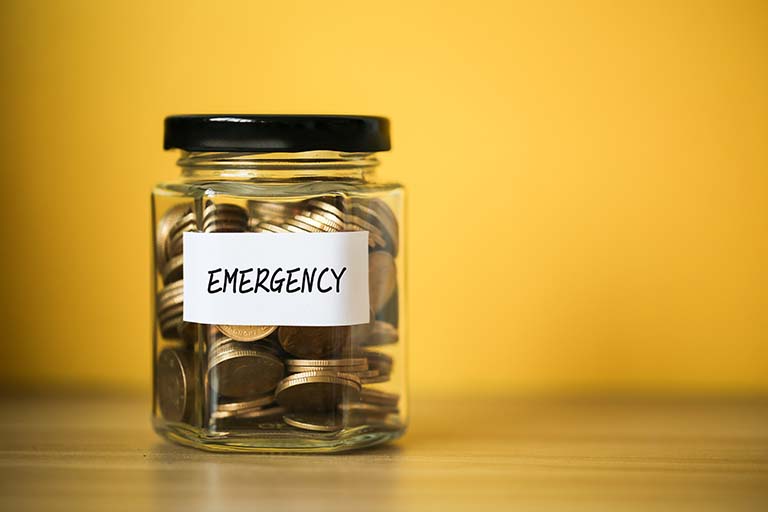Most of us have experienced a financial emergency at one time or another—an unexpected medical bill, a fender bender, a broken appliance, or even the loss of income altogether. Unexpected hardships like these are why emergency funds have become an essential part of financial planning. While they can’t make all your problems disappear, they can help make a challenging situation just a little bit easier.
If they were to lose their job tomorrow, 2 in 3 Americans would be worried about having enough savings to cover a month’s living expenses.1
What is an emergency fund?
An emergency fund is a designated savings account for unexpected expenses or financial emergencies. Its primary purpose is to prevent individuals from relying on high-interest loans or credit cards to cover these expenses, thereby helping maintain financial stability.
Who should have an emergency fund?
Everyone should have an emergency fund because life is inherently unpredictable, and unexpected financial challenges can arise anytime.
In the three months prior to May 2023 alone, “nearly half (46%) of U.S. consumers stated they faced an unexpected emergency, with millennials and high-income consumers facing them at even higher rates. In this same timeframe, consumers earning more than $100,000 annually were 34% more likely to have faced emergency expenses than their low-income counterparts2”
Whether it’s a sudden job loss, a medical emergency, or a major car repair, having an emergency fund can help provide a safety net to weather these storms. Without an emergency fund, individuals risk financial instability and may struggle to cover essential expenses during times of crisis, leading to even more stress and uncertainty.
How much should I put in my emergency fund per month?
Determining how much you should put in your emergency fund per month will vary by household. Consider all your lifestyle factors, including monthly costs, income, and dependents. Then, determine an emergency fund amount that could comfortably cover three to six months of your total monthly expenses.
As you tally your total, concentrate on the necessities for your home, including:
- Childcare
- Debt
- Food
- Health care (including insurance)
- Mortgage/rent
- Personal expenses
- Transportation
- Utilities
Eliminate luxury or discretionary items from your calculation, as you would want to pause those purchases in an emergency. Items that fall under this category may include:
- Entertainment
- Dining out
- Monthly subscriptions (food service apps, digital platforms, streaming platforms)
- Nonessential shopping
- Savings account contributions
- Vacations
How to build an emergency fund
You can start building an emergency fund by setting a realistic savings goal. Experts recommend saving three to six months’ worth of living expenses – but don’t let that number scare you. That’s the end goal.
Prioritize contributing to your emergency fund every month, even if it’s a small amount. You may opt for a specific dollar amount, like $50, or target a percentage of your monthly income. Either way, choose a number and stick with it. Automate your savings whenever possible to make it easier to stick to your plan. Over time, your emergency fund will grow.
Where to keep emergency fund
When deciding where to keep your emergency fund, prioritize accessibility and safety. Open a separate account specifically for your emergency fund to prevent it from getting mixed up with your regular spending. You should also refrain from placing the money in long-term investments that make it difficult and costly to get your cash when needed.
Benefits of an emergency fund
As we’ve discussed, emergencies — from a broken kitchen appliance to a broken bone — are unpredictable.. The good news is that the benefits of building an emergency fund extend beyond just helping protect your financial future. An emergency fund can also help provide peace of mind for loved ones, curb impulse buys, reduce stress, and decrease the need for unfavorable lending options.
Peace of mind for loved ones
Having an emergency fund means you can better prioritize your family’s well-being during challenging times without the added stress of financial uncertainty. With funds set aside for unexpected expenses, you and your loved ones can concentrate on getting through the tough times together.
Help reduce stress
It’s easy to see how an emergency fund may help reduce stress, especially when 71%3 of U.S. adults identify money as a significant cause of stress in their lives. While an emergency fund can’t solve all your problems, it can help you recover more quickly from unexpected setbacks.
Curb impulse buys
Prioritizing contributions to an emergency fund can help promote good saving habits. Plus, when your emergency fund is safely tucked away in a savings account you don’t regularly use, you’re less likely to use the cash for an impulse buy.
Decrease dependence on poor lending options
In an emergency, 21%4 of Americans say they would put the cost on a credit card. With the average credit card interest rate in the U.S. settling at 24.66%5, you’d likely end up financing the emergency and then some, with all the extra fees. With an emergency fund in place, you can have more flexibility to make decisions based on your financial situation rather than being forced to rely on unfavorable lending options.
Savings vs. emergency fund
Contrary to popular belief, an emergency fund differs greatly from a savings account. While you may store your emergency cash in a savings account, it’s important to note that the purposes of these funds are distinctly different.
An emergency fund is specifically designated to provide immediate access to funds during times of crisis. It should be kept separate from regular savings to avoid using them for non-emergency expenditures. On the other hand, a savings account is a general-purpose account designed to save money over a longer period of time for various goals, such as vacations, home purchases, or retirement.
While both types of accounts help promote financial security, emergency funds are specifically tailored to help provide immediate financial relief during unexpected events, whereas a savings account serves broader savings goals and objectives.
Start your emergency fund
Starting an emergency fund is a simple yet crucial step toward financial preparedness.No matter your financial situation, you should prepare for the unexpected. After all, having an emergency fund could mean the difference between getting through a financial hardship or digging yourself into a bigger one.
- https://www.bankrate.com/banking/savings/emergency-savings-report/#rising-prices
- https://www.apa.org/news/press/releases/stress/2013/stress-report.pdf
- https://www.apa.org/news/press/releases/stress/2013/stress-report.pdf
- https://www.bankrate.com/banking/savings/emergency-savings-report/
- https://www.bankrate.com/banking/savings/emergency-savings-report/


